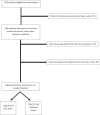Observation tool to measure patient-centered behaviors on rounds in an academic medical center
- PMID: 34994682
- PMCID: PMC8745350
- DOI: 10.1080/10872981.2021.2024115
Observation tool to measure patient-centered behaviors on rounds in an academic medical center
Abstract
Objective: As part of a quality improvement project, we developed and employed an observation checklist to measure patient-centered behaviors during daily rounds to assess the frequency of patient-centered behaviors among a patient-centered care (PCC) team and standard team (ST) rounds.
Patients and methods: On four general medicine service (GMS) teaching teams at an urban academic medical center in which housestaff rotate, we utilized an observation checklist to assess the occurrence of eight behaviors on inpatient daily rounds. The checklist covered domains of patient-centered communication, etiquette-based behaviors, and shared decision-making. One GMS team is guided by a PCC curriculum that emphasizes patient-centered communication strategies, but not specifically behaviors during bedside rounds.
Results: Between August 2018 and May 2019 a trained observer completed 448 observations of patient rounding encounters using the checklist. Across all teams, 46.0% of the 8 behaviors were performed when possible, with more done on the PCC team (58.0%) than ST (42.0%), p < 0.01.
Conclusions: Performance of patient-centered behaviors during daily rounds was low overall. Despite having no specific instruction on daily rounds, patient-centered behaviors were more frequent among the teams which were part of a PCC curriculum. However, the frequency of observed behaviors was modest, suggesting that more explicit efforts to change rounding behaviors are needed. Our observational checklist may be a tool to assist in future interventions to improve patient-centered behaviors on daily rounds.
Keywords: Patient-centered care; education; patient-centered communication; rounds; shared-decision making.
Conflict of interest statement
No potential conflict of interest was reported by the author(s).
Figures
References
-
- Castro EM, Van Regenmortel T, Vanhaecht K, et al. Patient empowerment, patient participation and patient-centeredness in hospital care: a concept analysis based on a literature review. Patient Educ Couns. 2016;99(12):1923–8. - PubMed
-
- Institute of Medicine (US) Committee on Quality of Health Care in America. Crossing the Quality Chasm: a New Health System for the 21st Century. Washington (DC): National Academies Press (US); 2001. 49–51; Accessed 17 February 2018. PMID: 25057539 - PubMed
-
- Hall JA, Roter DL, Rand CS. Communication of affect between patient and physician. J Health Soc Behav. 1981;22(1):18–30. - PubMed
MeSH terms
Grants and funding
LinkOut - more resources
Full Text Sources
Research Materials

